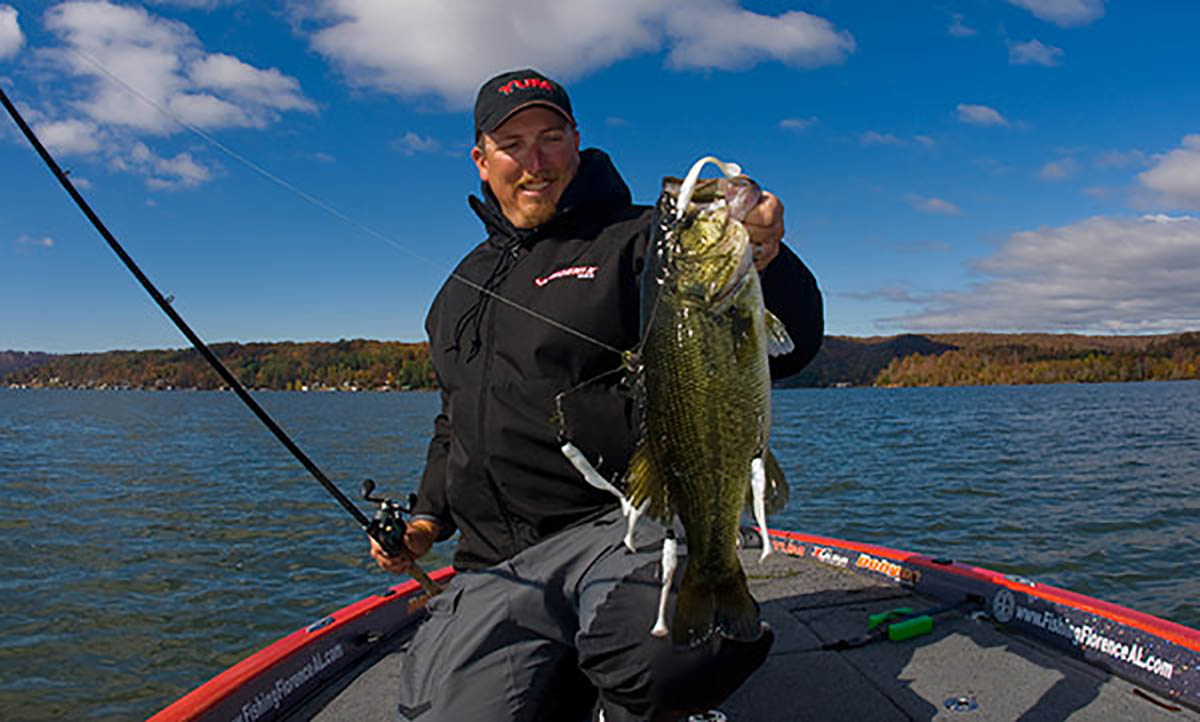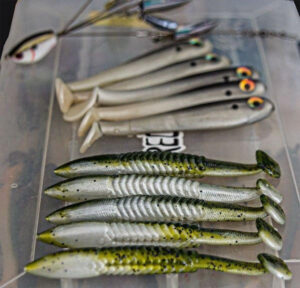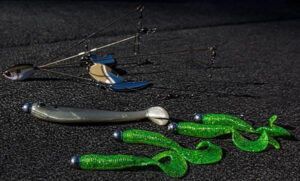Although the excitement surrounding the Alabama Rig and subsequent rigs has largely died down in the past year, castable bass umbrella rigs remain effective fish catching tools under the right conditions. Alabama fishing guide Jimmy Mason has zeroed-in his approach to the rig over the past two years. He narrowed down bait selection to two important environmental cues
- Water clarity
- Water temperature
Clear water
The most important factor to Mason’s bait selection is water clarity. In clear water, the eyesight of a bass is largely enhanced, making a proper presentation a huge factor of success. In these high visibility situations, he doesn’t get too creative when chunking an umbrella rig.
“The clearer the water is, the more I want my baits to match,” Mason said. “It’s much more natural for the bass to see a ‘school’ of matching baits, so I want to throw 5 identical baits.”
While clear water does dictate a set of matching baits, the color of these baits is equally important. Just as he would opt for more natural-colored hard baits in clear water, Mason keeps this philosophy intact when he’s on a hot rig bite.
“I’m a big believer in translucent baits in clear water,” Mason said. “One of my most productive baits in these conditions is the 3 1/2-inch Emerald Pearl-colored Yum Mud Minnow, especially on sunny days. When the sun reflects off of the green flake, it’s a dynamite combination.”
Stained water
As long as the water has at least 1 foot of visibility, Mason doesn’t hesitate to throw a bass umbrella rig. When faced with these low-visibility water conditions, he tends to get a bit more technical with his bait selection. Larger baits and brighter colors have produced some unforgettable fishing days for him in the past year.
“In dirty water, I’m going to play with my baits a lot more,” Mason said. “I love using 5-inch Yum Money Minnows in the middle of the rig because they give it a much bigger profile that displaces a lot more water. This extra visibility and water disturbance draws attention to my Yumbrella Rig a lot better than smaller baits would.”
The Tennessee River system received an insane amount of rain last year, but that didn’t stop Mason from putting his clients on monster bass. With the river continuously moving at nearly 100,000 cubic feet per second, the muddy water forced him to improvise his A-rig approach.
“The only way we could get consistent bites was by using 5-inch chartreuse grubs on the outsides,” Mason said. “I was running a full size, 5-inch Money Minnow in the middle and the 5-inch grubs on the outside of the rig in order to help the bass see the bait better. It ended up reducing our short strikes and dramatically increasing our hookup ratio.”
Water temperature
As with any bass fishing technique, water temperature is an essential element in Mason’s Alabama rig bait selection process. In water temperatures above 50-degrees, big bass won’t hesitate to attack an A-rig with 5-inch swimbaits, but when the water drops to below 45- to 50-degrees this time of year, downsizing baits can make a lot of difference.
“Whenever the water temperature gets below 50-degrees, bass become lethargic,” Mason said. “A big, bulky presentation isn’t appealing to these wary bass, and can actually spook them. This is a time where I like to use 5-inch grubs on the outside of my rig””it’s less imposing and matches small forage better.
Umbrella rigs never ended up being the “magic baits” that some anglers thought they would be, but that doesn’t mean they won’t catch fish. Keeping a close eye on the surrounding water clarity and water temperature not only leads to smarter bait selection, but also more fish in the boat.














